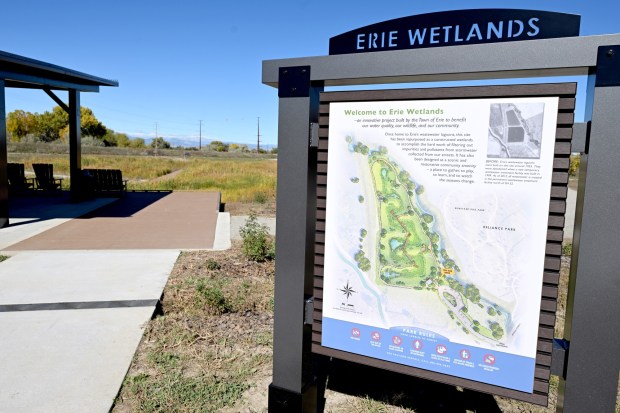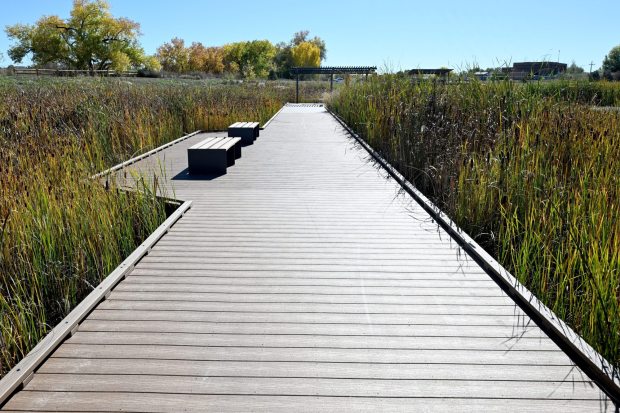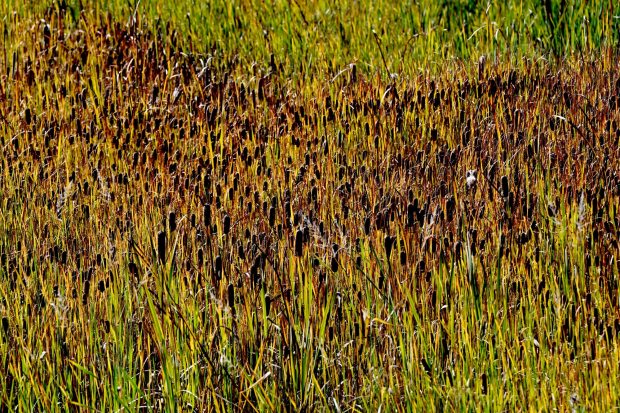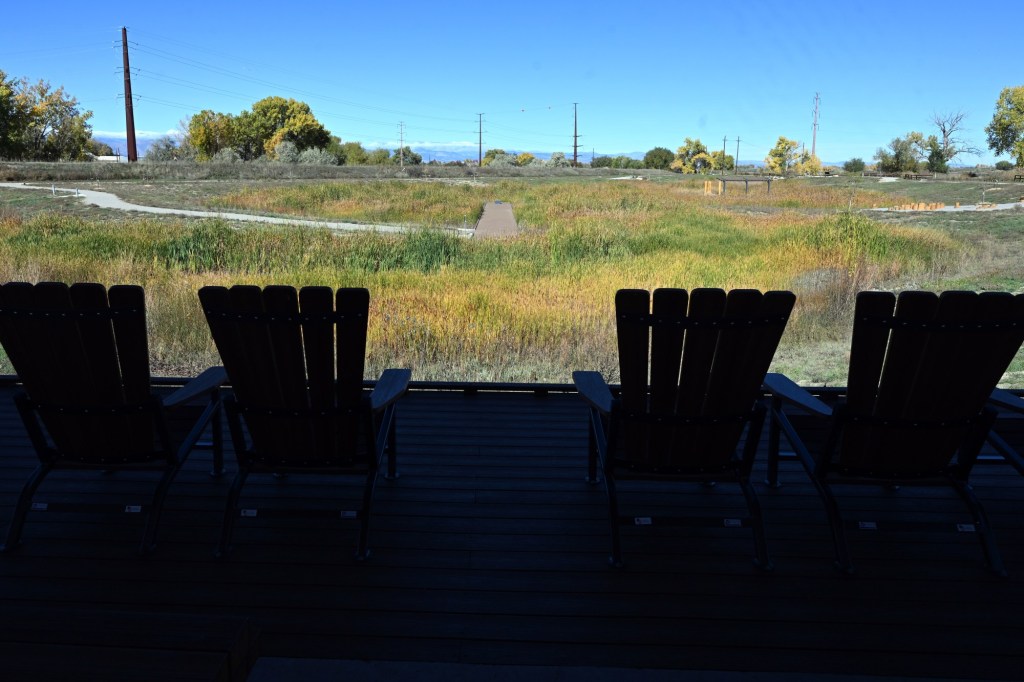Just across Coal Creek from Erie’s Reliance Park, a new trail and boardwalk wind through a large space with grassy wetlands — now open to the public.
A grand opening on Saturday marked the completion of the Erie Wetlands project at 1000 Briggs St., which began construction in 2023. Creating the Erie Wetlands, a roughly 10-acre space, meant converting wastewater lagoons into water quality ponds, also called “constructed wetlands,” according to town spokesperson Gabi Rae.
 The Erie Wetlands at 1000 Briggs St. neighbors Reliance Park. (Photo by Cliff Grassmick/Staff Photographer)
The Erie Wetlands at 1000 Briggs St. neighbors Reliance Park. (Photo by Cliff Grassmick/Staff Photographer)
Erie started planning in 2021 to convert the wetland space near its recycling center and defunct water treatment plant, the town’s website says. The man-made lagoons were built around 1955 and abandoned about four decades later, according to the town. A former part of the treatment facility, they used biosolids — nutrient-rich organic materials — to break down waste, treat sewage and purify water.
When the water treatment plant was decommissioned and repurposed into a recycling center, the town no longer needed those biosolids and the lagoons that held them. To create the wetlands, about 7,000 tons of biosolids were removed and transported to an approved disposal site before the area was reseeded and restored with wetland plants, trees and shrubs, Rae said.
From sunrise to sunset, visitors can now stroll a half-mile soft trail loop around the area or walk the elevated boardwalk through its tall grasses. The site also includes a pavilion, playscapes, seating areas and educational signage.
“Constructed wetlands” are stormwater control measures that can be effective in removing soluble pollutants like dissolved metals and nutrients, according to the town’s website.
 The Erie Wetlands includes a boardwalk for visitors to stroll through its tall grasses. (Photo by Cliff Grassmick/Staff Photographer)
The Erie Wetlands includes a boardwalk for visitors to stroll through its tall grasses. (Photo by Cliff Grassmick/Staff Photographer)
The $4 million Erie Wetlands project was funded with about $3.4 million from the town’s Storm Drainage Operating Fund and about $570,000 from its Trails and Natural Areas Fund. The project also demolished the area’s wastewater basins for $348,000, covered by the town’s Wastewater Fund, Rae said.
Erie’s Coal Creek plan
Saturday’s grand opening was also planned to celebrated a new King Open Space Trail connection that opened earlier this year. The King Open Space and the new section of the Coal Creek Trail between County Line Road and Kenosha Road have been open since June 18, according to Rae.
The Creek Restoration and Trail Project on King Open Space added the new half-mile section of the Coal Creek Regional Trail, and engaged in vegetation restoration throughout the corridor with wetland plants, trees and shrubs, according to the town. It also included rerouting and reconstructing Coal Creek to reduce flood potential, cut sedimentation and improve erosion control, Rae said.
The King Open Space project is part of Erie’s larger Coal Creek Restoration, Flood Control and Trail Project, which is being completed in phases, Rae said. Design work began in 2017 for the effort which would stretch from Cheesman Street all the way to Kenosha Road once completed.
According to Rae, the Mile High Flood District handled funding for the construction of creek sections along the east side of Old Town and King Open Space — both of which have already been completed. The town estimated construction costs for that phase of the project at about $3 million for the Old Town section and about $6 million for the King Open Space section, not including design expenses.
The next phase of the creek restoration project, between WCR 1.5 and County Line Road, is nearing design completion. Erie received a FEMA grant to fund the design work and is now awaiting approval for the construction grant. That section would complete the remaining improvements along Coal Creek, including realigning the trail, according to the town.
The design for the last phase is currently priced at $1.28 million, funded mostly by FEMA through a 90% match ($1.15 million), with the town of Erie contributing the remaining 10% ($128,000), Rae said.
Construction for that phase is estimated at $24.15 million, with FEMA expected to contribute up to $14 million. The rest of the funding would come from the town’s Storm Drainage Fund and Transportation Fund, and Mile High Flood District is expected to help with some of the costs for the work that is within Boulder County, Rae said.
 Waves of cattail plants at the Erie Wetlands, which opened to the public on Oct. 18.(Photo by Cliff Grassmick/Staff Photographer)
Waves of cattail plants at the Erie Wetlands, which opened to the public on Oct. 18.(Photo by Cliff Grassmick/Staff Photographer)
Both the Erie Wetlands and Coal Creek restoration projects are intended to serve the community not only as recreational spaces but also as key investments in water quality and flood mitigation, Rae said. Both sites immerse visitors in nature with “birdwatching opportunities and passive recreation.”

